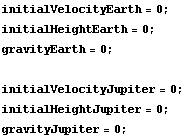
Quadratic Functions 1.1
Student Name:
Applying the Force of Gravity on a Falling Object
One of the most important roles of the quadratic functions is modeling the path of a falling object.
Without gravity, if you threw a ball upward at 5 meters per second from 2 meters above the ground, the ball would keep moving upward at that velocity. After t seconds, it would be  meters above the ground. See Graph #1. Notice that the graph is drawn for only 2 seconds.
meters above the ground. See Graph #1. Notice that the graph is drawn for only 2 seconds.

However, on Earth gravity pulls down on the ball in a negative direction. The force of gravity is modeled by an additional term in the height equation,  . Now a quadratic function can easily be written to demonstrate the path of the falling object with gravity pulling it down toward the ground. See Graph #2.
. Now a quadratic function can easily be written to demonstrate the path of the falling object with gravity pulling it down toward the ground. See Graph #2.

From this new quadratic graph we see that the falling object will reach a maximum height of about 3.3 meters, at 0.5 seconds, and will hit the ground (when it crosses the x-axis) after about 1.3 seconds.
Practice Problems
Each of the following problems will give you practice using this "falling object" function to make predictions about the object along its path.
After reading each problem make the appropriate changes in each variable, press 

 to generate a new graph, and write your answers in the space provided in this notebook. When you have finished all five problems, print the entire notebook.
to generate a new graph, and write your answers in the space provided in this notebook. When you have finished all five problems, print the entire notebook.
Problem 1: Cliff Diving
Acapulco, Mexico is famous for cliff diving competitions. Divers climb up steep cliffs, wait for a large wave to raise the water level, and then dive into the ocean. You are about to make your first dive. You climb to a ledge that is 20 meters (about 60 feet) above the water. After waiting to get up enough nerve to dive, you push off the cliff at a force of 2 meters per second.
Fill in the initial values for the following variables and plot the path of your dive.


a.) What is the maximum height you would reach as you begin your dive?
0 meters
b.) How long would it take before you hit the surface of the water?
0 seconds
Problem 2: Sears  Daredevil
Daredevil
The Sears Tower, in Chicago, Illinois, is the tallest building in the world. It measures 443.179 meters from the ground to the very top. You are a very brave daredevil and you decide to jump (with a parachute) from the roof of the Sears Tower, at 440 meters to the sidewalk below. You jump off the roof with a force of 1 meter per second.
Fill in the initial values for the following variables and plot the path of your dive.


You've decided to jump a second time. You are hoping that if you jump with greater force the second time, you will have more time to enjoy the fall. On your second jump you have a force of 3 meters per second.
Fill in the values comparing your first jump with your second.


Warning! Watch the x-axis, make sure it is
going all the way down to zero !
The red path is the first jump with a velocity of 1 meter per second. The blue path is the second jump with a velocity of 3 meters per second.
Notice that the second path does not cross the x-axis. Go back and recalculate your graph, allowing enough time to pass to see the intersection. (Hint: You will need to change one value in the last Plot command. Look for a value that is 2 and change it to the new value your pick.)
a.) What is the maximum height you would reach as you begin your dive?
First jump maximum height= 0 meters
Second jump maximum height= 0 meters
b.) How long would it take before you hit the surface of the ground?
First jump time of impact= 0 seconds
Second jump time of impact= 0 seconds
Problem 3: Jupiter Jumping
On the surface of Jupiter the force of gravity is 2.64 times greater than on Earth's surface (which was -4.9 in the previous problems). Recalculate the first problem comparing the gravity on Earth with the gravity on Jupiter. Fill in the initial values for the following variables and plot the path of your dive.


a.) Which color path represents Earth? Which color path represents Jupiter?
Red Path=
Blue Path=
b.) What is the maximum height you would reach as you begin your dive on Earth?
0 meters
c.) What is the maximum height you would reach as you begin your dive on Jupiter?
0 meters
Before answering the next questions, make sure both paths are crossing the x-axis. You may need to change a Plot parameter in order to get the graph displaying all of the important information.
d.) How long would it take before you hit the surface on Earth?
0 seconds
e.) How long would it take before you hit the surface on Jupiter?
0 seconds
Problem 4: Write and Solve Your Own Problem
Type your own problem here:
Fill in the initial values for the following variables and plot the path of your dive.


Write a summary of your findings here: